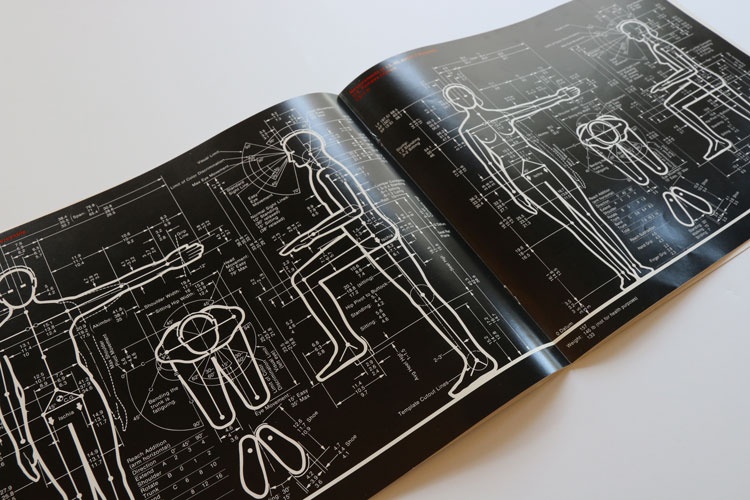Humanscale: the classic guidelines helping designers create products for people
As a new crowdfunder launches to reissue the Humanscale manual from the 1970s, we speak to the team behind the campaign about why keeping historic designs such as standards manuals alive is so important.

Originally produced between 1974 and 1981, US consultancy Henry Dreyfuss Associates’ Humanscale manual was conceived for designers to refer to when creating everything from tractors to telephones.
Comprising three books and nine different measurement selectors – types of measurements for different situations and parts of the human body, such as hands and feet – the manual has since gone out of print, and become difficult and expensive for designers to get hold of.
Now, consultancy IA Collaborative has launched a crowdfunding campaign in collaboration with the original designers to reissue the Humanscale manual. We speak to IA Collaborative’s design engineering director Luke Westra, senior design researcher Nathan Ritter, and founder and chief design officer Dan Kraemer about the inspiration behind the project.
Design Week: What was Henry Dreyfuss Associates and what was the idea behind its original Humanscale manuals?
Luke Westra: Henry Dreyfuss Associates was a legendary design consultancy responsible for designing some of the most ubiquitous products of 20th century American life: the modern telephone for Bell Laboratories; the Hoover vacuum; the John Deere tractor; and the Polaroid camera. Having seen the impact of human factors data – or ergonomics – on their own work, they decided to document everything they had learned about designing products for people in the form of the Humanscale manuals. These comprised 60,000 bits of impeccably organised and elegantly designed information about every facet of human existence.
DW: Where and in what capacity are the manuals used today?
LW: If they are lucky enough to get their hands on them, industrial designers, architects and engineers like us use them as a helpful reference in the early stages of the design process, to set a starting point for product and space dimensions and specifications.
DW: How did the crowdfunding campaign come about?
Dan Kraemer: About 18 months ago, I created IA Collaborative’s ventures programme to fuel IA’s entrepreneurial culture and pursue work that we truly believe in, including passion projects like Humanscale. Human-centred design is a core value of IA Collaborative. Reissuing Humanscale – a foundational tool to design for people – was a natural choice for our ventures programme.
LW: We’ve been enamoured with Humanscale for a long time, as it’s exactly the kind of reference guide that anyone designing for people needs. But when we tried to locate an actual copy of it, we found that the out-of-print materials were difficult to find, and commanded high prices on the secondary market. It very quickly became evident that these manuals deserve to be reprinted, and that through our ventures programme and this crowdfunding campaign we could reprint it ourselves and bring it back for all to appreciate and enjoy.
DW: What do you think makes the manuals so visually appealing?
DK: Humanscale is a striking and intricate example of information design. From the bold colour palette to the iconic line art, the tools draw the user in and are simply beautiful to look at. Upon closer inspection, you start to appreciate the many layers of information, as well as the depth and breadth of the content. Between the booklets and data selectors, the original creators synthesised and presented over 60,000 bits of data in a format that is intuitive to use – and the result is stunning.
DW: What are the main design features of the reissued manuals?
Nathan Ritter: For this historic reissue we are bringing back Humanscale as a faithful reproduction of the original materials. The most engaging aspect of the Humanscale tools is their interactivity – the tactile nature of the process of moving a dial to select data points such as age and height helps you to focus on only the relevant information. To maintain these tools in their original form, we are working with the original manufacturer of the measurement selectors to bring them back with the same materials and precision printing processes. In addition to the selectors, each of the three sets includes a booklet with more data, guidance on best practices, exhaustive reference lists and more beautiful illustrations. These booklets will be printed using high-quality scans of the original materials.
DW: Why do you think it is important to preserve pieces of design history like these?
LW: In our own work, we are strong believers in the power of human-centred design, and having a deep understanding of human factors is an important aspect of the design process. As technology has evolved to push design tools toward a more digital process, it’s easier than ever to create things virtually. We believe it is critically important to maintain a connection to the people you are designing for, and Humanscale provides designers with a great starting point. Additionally, the Humanscale manuals remind designers that sometimes analog tools and interfaces can effectively and succinctly present a multitude of data and provide users remarkable utility.
The crowdfunding campaign to reissue the Humanscale manuals runs until 24 August 2017. Find out more info here.



















These would make great wall art hangings. Does anyone know if they were ever licensed for this purpose?
This is a great idea, but only worth doing if the anthropometric data is brought up to date. A lot of the sources are now over half a century old and there have been big shifts in linear dimensions and body weight in that time.
A really striking early example of info graphics at its best.